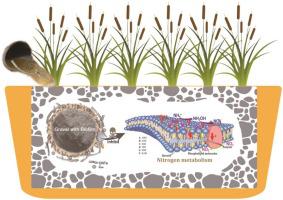Journal of Hazardous Materials ( IF 12.2 ) Pub Date : 2020-06-22 , DOI: 10.1016/j.jhazmat.2020.123270 Xiangyu Yang 1 , Qiang He 1 , Fucheng Guo 1 , Xiaohui Sun 1 , Junmao Zhang 1 , Yi Chen 1

|
The increasing use of raw carbon-based nanomaterials (CBNs) will inevitably affect wastewater treatment systems. Constructed wetlands (CWs) are ecological wastewater treatment facilities and can intercept the vast particles pollutant, including CBNs. However, the impacts of CBNs on the treatment performance of CWs have no available knowledge. Therefore, we systematically inspected the effects of single-walled and multi-walled carbon nanotubes (SWCNTs and MWCNTs) and fullerene nanoparticles (C60) on CW performance under 180-day exposure to 0, 10 and 1000 μg/L concentrations. The results showed that CBNs had marginally adverse impacts on chemical oxygen demand (COD) and total phosphorus (TP) removal, whereas nitrogen removal declined by 24.1 %–42.7 % following long-term exposure to CBNs. MWCNTs had the greatest inhibition effect on nitrogen removal, followed by SWCNTs and C60. The CBNs also induced reactive oxygen species (ROS) overproduction as the increasing concentration, which confirmed that CBNs have biotoxic effects in CWs. The variation of functional microbial community and the inhibition of enzyme activities were the dominant reasons for the decline in nitrogen removal efficiency. Furthermore, predictive functional profiling showed that CBNs affected functional gene abundance, and caused a decline in the enzymes abundance connected to nitrogen removal by the end of the 180-day exposure period.
中文翻译:

碳基纳米材料对人工湿地中养分去除的影响:微生物群落结构,酶活性和代谢过程。
越来越多地使用原始的碳基纳米材料(CBNs)将不可避免地影响废水处理系统。人工湿地(CW)是生态废水处理设施,可以拦截包括CBN在内的大颗粒污染物。但是,CBN对CW的处理性能的影响尚无可用的知识。因此,我们系统地检查了单壁和多壁碳纳米管(SWCNT和MWCNT)和富勒烯纳米颗粒(C 60)暴露在0、10和1000μg/ L浓度下180天的连续波性能。结果表明,CBNs对化学需氧量(COD)和总磷(TP)的去除有轻微的不利影响,而长期接触CBNs的氮去除量则下降了24.1%–42.7%。MWCNTs对脱氮的抑制作用最大,其次是SWCNTs和C 60。随着浓度的增加,CBNs还诱导了活性氧(ROS)的过量生产,这证实了CBNs对CWs具有生物毒性作用。功能性微生物群落的变化和酶活性的抑制是脱氮效率下降的主要原因。此外,预测性功能分析表明,CBN会影响功能基因的丰度,并导致在180天暴露期结束时与脱氮有关的酶丰度下降。











































 京公网安备 11010802027423号
京公网安备 11010802027423号